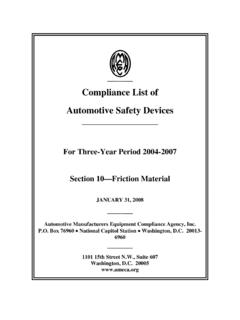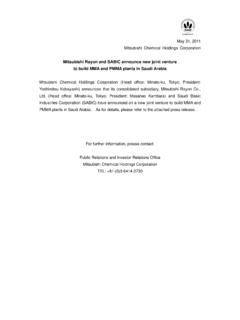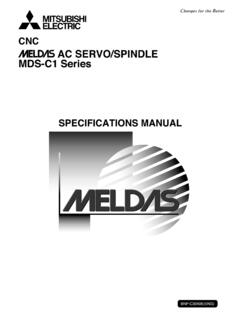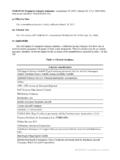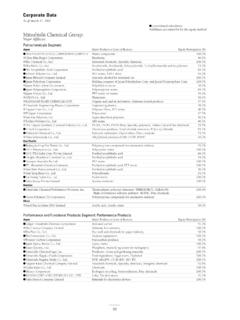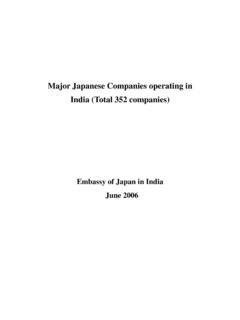Transcription of AMECA Spring 2008 List of Acceptable Plastics
1 AMECA List of Acceptable Plastics for Optical Lenses and Reflex Reflectors Used on Motor Vehicles Spring 2008 Edition Automotive Manufacturers Equipment Compliance Agency, Inc. Box 76960 National Capitol Station Washington, 20013-6960 1101 15th Street , Suite 607 Washington, 20005 1. STATUS The following materials have been accepted by the Automotive Manufacturers Equipment Compliance Agency as meeting the 3-year weathering test of SAE J576 (as amended in 49 CFR ) for Plastics used in optical lenses and reflectors used on motor vehicles. No evaluation has been made as to the suitability of individual materials for particular automotive uses, or to the manufacturing methods. You must contact the resin or coating manufacturer to determine the best material for your application.
2 Every manufacturer has specialized products for different applications, processing conditions, manufacturing equipment, light sources and final use. Please use the manufacturer addresses and websites in each listing for more information. The device manufacturers must ensure that the lenses molded from Acceptable materials meet the color and plastic stability test requirements for each individual device. 2. LISTING The material is listed by the manufacturer's name, trade name and flow formulation, type of resin, color number and color. 3. material COATINGS AND HAZE When these materials are used for state/provincial regulated lighting device lenses, the applicable state/provincial regulations shall be met. The Code "Q" denotes material that must be coated to pass the weathering test.
3 The material may be used for any device after it is so coated. The Code "#" denotes material which must be coated to pass the 7% haze requirement for use in lenses of reflex reflectors or in lenses in front of reflex reflectors. This material does not need to be coated to meet the 30% haze requirement. This material is Acceptable for lighting equipment required by 49 CFR when coated with the proper coating. Reflex reflectors shall meet the haze requirements of SAE J576, JUL 91, paragraph The Code "$" denotes material with up to 30% haze that is Acceptable for lighting equipment required by 49 CFR , but which cannot be used in lenses of reflex reflectors or in lenses in front of reflex reflectors. Reflex reflectors shall meet the haze requirements of SAE J576, paragraph The Code "!
4 " denotes a material that does not require a coating to be used as an inner lens when protected by an outer lens designated by Code "# 4. DISTRIBUTION This list is distributed free on a semiannual basis and is subject to change twice a year. Any revised or pre-release editions may be obtained by contacting AMECA . 5. DEFINITIONS Coating -- material applied to surface of the lens to improve some aspect of performance. Hard Coat -- 1) Coating which is cured by UV radiation. 2) Coating which provides additional resistance to abrasion or scratching which may be cured by thermally or by UV radiation. May contribute to long term durability of material . NOTE: Both definitions are being used--please verify the intended performance when discussing hard coats.
5 UV-protective Coat -- Coating designed to provide additional protection from the sun's electromagnetic radiation, particularly those wavelengths in the UV bandwidth. Often used on polycarbonate substrates to improve weathering performance. Polycarbonates must be coated for use in or in front of reflex reflectors. Substrate -- Base material to which all other performance enhancing materials are added. UV radiation -- Short wavelength, high energy radiation emitted by the sun or other object (HID lamp). Wave lengths between 10 and 380 nm. HID Lamp -- High Intensity Discharge Lamp. Lamps produce light by the use of a stabilized arc. Lamps can produce significant UV radiation which may require special materials. See SAE J-1647 6.
6 NOTE ON COLOR The colors listed have been determined to be in compliance with SAE J-578 using the ASTM E 308-66 method for all thicknesses required by FMVSS 108 or in thicknesss specified by the resin manufacturer (SAE J576 ) for non-FMVSS applications. The ASTM E 308-66 method uses an illuminant A light source energized to 2856k. If you use anything other than an incandescent light source at 2856k you MUST verify that the resulting color meets the specifications of SAE J-578 for every thickness. Halogen light sources at 3200k, illuminant C (strobe) and LED light sources will dramatically alter the color output. In addition, some light sources do not emit color or luminous flux uniformly. Measurements should be made to verify that the emitted light using your intended lightsource meets the specifications of J-578 throughout its photometric range.
7 7. NOTE ON INNER LENS COLOR Combinations of inner and outer lenses with various colors may not perform predictably. Check with the manufacturer s color specialist when making selections 8. NOTE ON EQUIVALENT FORMULATIONS. Many companies have distributed manufacturing facilities, cooperative agreements or joint ventures. In order to list a facility or another company the company which has done the three year weathering testing must send documentation stating that the materials, processes and end products are equivalent between itself and the new applicant. Due to industry complaints, the List of Acceptable Plastics has revised the listing to more accurately reflect the test data from various parent companies. In addition, if the joint venture is terminated or the manufacturing facility is sold, the subsidiary or joint company must be able to provide weathering test data on its own.
8 A company can no longer rely on the parent company data and processes if they have no relationship to the parent company who conducted the original testing. 9. NOTE ON SAE J-576 FORMATTING In 2003 SAE reformatted J576 JUL91. Section 2 References was split into two sections, Section 2, References and Section 3 Definitions. Please check the formatting used during communication and verify you are referring to the same edition. 10. NOTE ON SUBMITTING FOR ADDITIONAL COLORS If you plan to add an additional color number to your listing, please list the existing colors which have undergone the three year weathering that are a greater and lesser concentration. The colors listed MUST be in the same color space. See SAE J576, JUL91 Section 11. Note on FMVSS 108 Rewrite published December 4, 2007.
9 We are including both the 2007 edition of FMVSS 108 for Plastics and the rewritten version. There are some significant differences. Including specifying additional thicknesses, color requirements before and after testing and others. If you have any issues with the proposed changes, please write to the address below. Department of Transportation NHTSA Correspondence Unit 1200 New Jersey Avenue, SE, Room W41-306 Washington, 20590 Frequently Asked Questions Q1) If someone else has weathered a polycarbonate/PMMA material , do I have to weather my polycarbonate/PMMA material ? A) Yes, every company s material stands independently from what another company has done. Each coating, pigment and additive must be tested with each companiy s own material .
10 Each separate material stands alone for weathering performance unless bracketed by materials of higher and lower concentrations or molecular weights. Q2) If someone else has weathered a pigment with another plastic do I have to weather the pigment with my plastic? A) Yes, every company s material stands independently from what another company has done. Each coating, pigment and additive must be tested with each companiy s own material . Each separate material stands alone for weathering performance unless bracketed by materials of higher and lower concentrations or molecular weights. Q3) If someone else has weathered a coating do I have to weather my material with that coating? A) Yes, every company s material stands independently from what another company has done.


